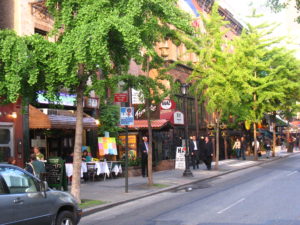
I want to present a situation I occasionally find myself in: while visiting a city and looking for dinner, I try my best to find an outstanding place to eat. To help make this decision, I usually turn to my phone and read restaurant reviews and menus online for 30 minutes hoping to find the perfect restaurant. As my hunger continues to grow, I think about all the restaurants I’ve looked at and settle on a restaurant that seems good enough. On my way to the restaurant, I second guess my choice, all the while fighting the hunger nipping at my stomach. After experiencing this restaurant conundrum too many times, I was left wishing there were a more efficient way to handle these choices.
Luckily, within mathematics there exists a theory, named optimal stopping, which has a technique that can be elegantly applied to this problem. Optimal stopping theory presents various methods to choose the best option out of a large number of choices or given a limited amount of time. Applying a technique from optimal stopping theory to my restaurant problem can guide me to the restaurant of my dreams.
Here’s how to handle this restaurant struggle using optimal stopping theory. Consider the same 30 minutes that I usually spend looking for the best restaurant. I take 37% of that time, about 11 minutes, and look at reviews and menus just as I have done many times before. This time, I spend these first 11 minutes only looking at restaurant choices and noting the most appealing choice. Once time is up, I continue scrolling through menus and reviews, remembering my previous tasty sounding choice, until I find a restaurant that sounds even better. This new, better restaurant is where I choose to go. I can now enjoy a meal, confident that I made a good choice and spared myself time before hanger sets in.
Where does this 37% number come from and what makes this technique so optimal? According to optimal stopping theory, when given a large number of options sampling the initial 37% gives sufficient perspective to find the best overall option. When using optimal stopping, as the number of choices increases, the probability picking the absolute best option closes in on 36.8%.
Finding the best option 36.8% of the time doesn’t sound that spectacular, but consider interviewing thousands of applicants for a job position that must be turned down or accepted on the spot. Using optimal stopping, the absolute best choice can be found 36.8% of the time regardless of the choices numbering in the twenties or twenty-thousands!
Optimal stopping is not limited to picking a place to eat; it can be applied to many everyday situations. What if you want to spend as little effort as possible online dating, but still want to find your soulmate? Optimal stopping theory to the rescue! Facing a staggering number of porta potties and want to touch as few handles while finding the cleanest toilet possible, optimal stopping theory will save the day. Trying to get the best deal selling your brother’s beanie babies on Craigslist? Optimal stopping can help you out.
So how can you find the king porta pottie, or the match of your dreams in the most efficient way? When presented a set of choices take 37% of the total number of choices, and skip past this first 37%. Importantly, you must keep in mind the best option from these choices. As you look over the rest of the choices, as soon as you find something better than what was in that first 37% that is your best choice.
This article was directly inspired by Numberphile and the podcast Note to Self, both of which are fantastic sources for how math can be applied to everyday problems.
Peer edited by Christina Parker.
Follow us on social media and never miss an article: